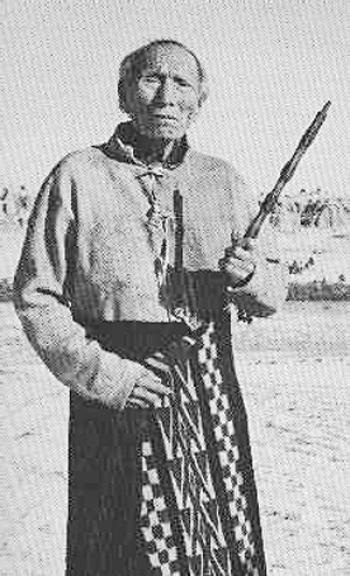By Dianne Meili
Windspeaker.com Archives
At the age of nine, the spirits entrusted Black Elk with no less a task than saving his Lakota nation.
No doubt other “wakan”—sacred men and women—received visions to help their people as well, but Black Elk’s story is the only one so well publicized. John G. Neihart, an American poet, immortalized the medicine man in the flawed “Black Elk Speaks” and Black Elk became a cultural icon.
In the “moon of the Popping Trees (December) in about 1863, a baby named Black Elk was born to Black Elk Sr., and his wife White Cow Sees, on Little Powder River in present-day Wyoming. This Oglala Lakota child, of Big Road’s band, was second cousin to the luminary Crazy Horse.
In the summer of 1872, when his band was moving slowly towards the Rocky Mountains, Black Elk was eating when he heard a voice say, “It is time; now they are calling you.”
The next day he was riding with some boys and his legs crumpled under him when he dismounted from his horse. He rode in a travois as the camp moved, his face puffed up and his legs and arms badly swollen.
Falling into a coma for the next 12 days, he travelled with two “spirit men”, who took him into the clouds where he observed his vision. Black, white, sorrels and buckskin horses danced before him and transformed into “every kind of animal and all the fowls that are.”
Ahead of him, heaped-up clouds formed a tipi with a rainbow over the open door and inside sat six old men.
Black Elk, in Neihart’s book, said he “shook all over with fear” because he recognized the grandfathers were “the powers of the world” or powers of the six directions.
He was blessed with thunder being medicine and given a special “four-rayed” herb with blue, white, red and yellow blossoms that could help his people be healthy. In the course of his vision he saw his Lakota people “thin, their faces sharp, for they were starving”, but he later saw them dancing in a “sacred hoop” around one mighty flowering tree.
Black Elk saw all of his people well and happy, except for one “lying like the dead.” That was himself, on the earth, lying in a coma. As one of the old men sang a sacred song, Black Elk returned to his body and sat up, to the delight of his heartsick parents who had kept vigil over their sick son.
In his teen years Black Elk told no one of his vision and strange things continued to happen to him when he was alone. He was confused about what he was supposed to do and he became terrified of rainstorms, lest the thunder beings come to him again.
During his early years, the first signs of great upheaval occurred. Europeans were beginning to travel through the sacred Black Hills, his Lakota homeland, and Black Elk found himself fighting, at 12, in the infamous 1876 Battle of Little Big Horn.
In his sixteenth year, Black Elk could think only of his vision during the Sun Dance and how he had not yet done anything about it. He stopped sleeping and became “queerer than ever.”
His concerned parents asked an old medicine man, Black Road, to help their son, and Black Elk finally told the Elder about the vision that was bothering him. To his relief, Black Road said he would help his nephew perform the vision on earth because that is what the grandfathers wanted him to do. During the vision’s re-creation, Black Elk saw his revelation again and feared it no longer. In fact, the thunder clouds came “as relatives came to visit me” and he began rising each morning with the daybreak star. Medicine people came to discuss his vision and he immersed himself in ceremony and healing.
Until he was 23 Black Elk cured the sick, but by 1886 he was depressed by the decimation of the buffalo and his nation’s hoop falling apart. In an attempt to understand white ways, he traveled “across the big water” to England with Buffalo Bill’s Wild West Show. There he danced and sang one day for Queen Victoria, whom he described as “little, but fat” and for whom he professed a great fondness.
When he missed his boat back to America, Black Elk joined another show and found himself deathly homesick in Paris. His girlfriend invited him to dinner, but suddenly, as he sat at the table, the roof opened up and he rose to “cling onto a cloud” and travel over “towns and green land” back to his Black Hills. In this out of body experience he saw his parents’ tipi and his mother standing outside it, then the cloud whisked him back to Europe.
When he finally returned, the Ghost Dance movement to eliminate Europeans and restore harmony, led by spiritualist Wovoka, was in full swing. As Black Elk danced, he “floated” upward into a different version of his original vision.
The huge conflict of his life–to satisfy his vision to save his people in the face of oppressing reality like the Wounded Knee Massacre, came into focus.
Though Niehart hardly mentions it, other historians say Black Elk was baptized and given the name ‘Nicholas’ after the death of his first wife in 1903. He became a catechist.
He continued to encourage his people as a spiritual leader, seeing no difference between his tribal traditions and what he found valid in Christianity.
He passed away on Aug. 17 or 19 (sources differ) in 1950, and published accounts of his life began to win wide interest and acclaim by the late 1960’s. Perhaps he has fulfilled his duty to the grandfathers in death, because so many people all over the earth have been inspired by his life.

